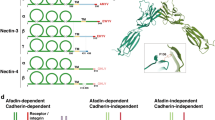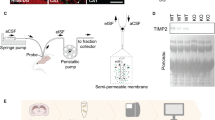Abstract
Many phenomena of short term adaptations of the CNS have been explained with changes in the conductance of ion channels, that are induced by cascades of second transmitter systems ultimately leading towards ion channel phosphorylation. On the other hand, it is the long-term consolidation of memory that appears to be vulnerable, in particular in the context of age-related disseases of which Alzheimer’s is but the most prominent example. A few years ago, cell adhesion molecules were considered just sticky agglutinants, but now it is well accepted that they are accurately regulated glycoproteins involved in li- gand-receptor relationships triggering intracellular second messenger cascades. They are known to guide axonal growth and the migration of neurectodermal cells during epige- netic differentiation. Also during CNS regeneration cell adhesion molecules are involved.
Access this chapter
Tax calculation will be finalised at checkout
Purchases are for personal use only
Preview
Unable to display preview. Download preview PDF.
Similar content being viewed by others
References
Schmidt, J.T., and Shashoua, V.E., 1988, Brain Res. 446: 269–284.
Schmidt, J.T., Schmidt, R., Lin, W., Jian, X., and Stuermer, C.A.O., 1991, J. Neuiobiol. 22: 40–54.
Königstorfer, A., Sterrer, S., Eckerskorn, C., Lottspeich, F., Schmidt, R., and Hoffmann, W., 1989, J. Neurochem. 52: 310–312.
Hoffmann, W., and Schwarz, H., 1996, Interntl Rev. Cytol. 165: 121–158.
Schmidt, R., and Shashoua, V.E., 1981, J. Neurochem. 36: 1368–1377.
Shashoua, V.E., Daniel, P.F., Moore, M.E., and Jungalwala, F.B., 1986, Biochem. Biophys. Res. Commun. 138: 902–909.
Schmidt, R., and Makiola, E., 1992, Life Sci. Advances 10: 161–171.
Ganss, B., and Hoffmann, W., 1993, Eur. J. Biochem. 217: 275–280.
Shashoua, V.E:, 1988, Neurochem. Res. 13: 649–655.
Rother, S., Schmidt, R., Brysch, W., and Schlingensiepen, K.-H., 1995, J. Neurochem. 65: 1456–1464.
Schmidt, R., 1989, Progr. Zool., Vol. 37 (Rahmann, H., ed.), Gustav Fischer Verlag, Stuttgart, New York,, PP. 327–339.
Benowitz, L.I., and Shashoua, V.E., 1977, Brain Res. 136: 227–242.
Piront, M.-L., and Schmidt, R., 1988, Brain Res. 442: 53–62.
Schmidt, R., 1987, J. Neurochem. 48: 1870–1878.
Schmidt, R., 1995, Behav. Brain Res. 66: 65–72.
Schmidt, R., Brysch, W., Rother, S., and Schlingensiepen, K.-H., 1995, J. Neurochem. 65: 1465–1471.
Meek, J., 1981, J. Comp. Neurol. 199: 149–173.
Schmidt, R., Rother, S., Schlingensiepen, K.-H., and Brysch, W., 1992, Progr. Brain Res. 91: 7–12.
Morris, M.E., Ropert, N., and Shashoua, V.E., 1986, Annals New York Acad. Sci. 481: 375–377.
Körtje, K.-H., and Körtje, D., 1992, J. Microscopy 166: 34–358.
Bailey, C.H., and Kandel, E.R., 1993, Ann. Rev. Physiol. 55: 397–426.
Murphy, K.J., O’Connell, A.W., and Regan, C.M., 1997, this volume.
Welzl, H., Becker, C., Artola, A., and Schachner, M., 1997, this volume.
Mileusnic, R., and Rose, S.P.R., 1997, this volume.
Author information
Authors and Affiliations
Editor information
Editors and Affiliations
Rights and permissions
Copyright information
© 1997 Springer Science+Business Media New York
About this chapter
Cite this chapter
Schmidt, R. (1997). Regulated Expression of the CNS-Specific Cell Adhesion Molecule Ependymin After Acquisition of an Active Avoidance Behaviour Provides a Possible Mechanism for Memory Consolidation. In: Teelken, A., Korf, J. (eds) Neurochemistry. Springer, Boston, MA. https://doi.org/10.1007/978-1-4615-5405-9_143
Download citation
DOI: https://doi.org/10.1007/978-1-4615-5405-9_143
Publisher Name: Springer, Boston, MA
Print ISBN: 978-1-4613-7468-8
Online ISBN: 978-1-4615-5405-9
eBook Packages: Springer Book Archive




